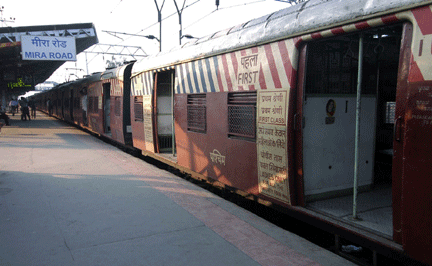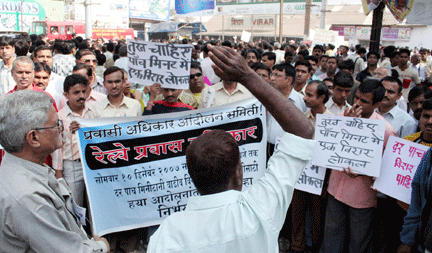 People's Democracy
People's Democracy
(Weekly
Organ of the Communist Party of India (Marxist)
No. 51
December 23, 2007
(Weekly
Organ of the Communist Party of India (Marxist)
|
Vol.
XXXI
No. 51 December 23, 2007 |
Historic Boycott

A deserted Mira Road railway station on boycott day at rush hour
HISTORY was created on December 10, 2007, World Humans Rights Day, in extended suburban Mumbai. Virar-Churchgate suburban train services ran empty for 12 hours from 6 00 a m to 6 00 p m, on 12 kilometer stretch, from Virar to Dahisar. About fifteen lakh commuters of Dahisar-Virar belt, extended suburbs, revolted against the inhuman conditions in which they travel every day. It was a spontaneous reaction to the intense anger of the commuters. The call was given by the Democratic Youth Federation of India led Pravas Adhikar Andolan Samiti (PAAS) comprising all major political parties functioning in the belt and scores of social, cultural organisations, residents associations etc.
The unprecedented boycott and the thumping response to it became the headline news for the media.Traveling in Mumbai suburban trains which are packed beyond the normal capacity, is a troublesome experience. But Virar trains are ‘torture chambers’ during peak hours with 17-18 persons traveling for more than an hour standing in one square meter space, unable to even breathe properly. A passenger falling from running train is normal. Suburban trains are called as Mumbai’s lifeline, but Virar trains are deathly, killing 1000 people every year.
The boycott was part of a sustained agitation conducted since November 2004. DYFI oganised a signature campaign for completion of Borivali-Virat railway track quadrupling project, a core demand then, with slogans asking not to treat local train travelers as animals. Twenty thousand signatures were submitted to Railway minister Lalu Prasad Yadav. On September 11, 2005, a ‘Right to Travel’ convention was held at Miraroad which was inaugurated by Basudeb Acharia, CPI(M) floor leader in Lok Sabha.
The idea of holding massive protest actions every year on World Human Rights Day, December 10, was to highlight the inhuman travel conditions in Virar local trains. The first programme was organised on December 10, 2005 when thousands of people responded to rail satyagraha call. Police lathicharged and used tear gas on the people at Nalasopara, slapped criminal cases with punishment ranging from ten years to life imprisonment against K K Prakashan, CPI(M) Mumbai committee member, Venugopalan, 12 DYFI activists and 18 others including three innocent women. Train services including the outstation ones like Mumbai-Delhi Rajdhani Express were disrupted for seven hours. The movement gathered further momentum and PAAS was formed. All accepted the DYFI as its leader and its state secretary Shailendra Kamble was chosen convener unanimously.

A dharna in progress in front of a railway station
A series of actions in various forms were conducted. Second ‘Right to Travel’ convention was held on October 29, 2006 at Vasai that was inaugurated by Sitaram Yechury, CPI(M) Polit Bureau member. DYFI and PAAS observed Humans Rights Day by staging a 12 kilometre youth protest march from Vasai to Mira Road in which 500 youth participated. Sitaram Yechury flagged off the march. Railway administration tried its best to prevent the march. Police served notices threatening stern action for any untoward incidents on Shailendra Kamble, Prakashan and others. Five hundred policemen including State Reserve Police were deployed to create an atmosphere of terror. Police miserably failed to thwart the programme. The march was a thumping success. The action received wide publicity. A PAAS delegation had a meeting with the Railway minister Lalu Prasad Yadav. Railway administration was forced to act and a series of actions in various forms were undertaken, quadrupling project was completed and new tracks were inaugurated by the Railway minister on July 7, 2007. He announced introduction of 157 new rakes very soon.
Lalu Prasad's announcement proved to be a hollow. Railway authorities did not keep their word. There were tracks but there were no rakes. Railway administration introduced only 20 additional services till December 10, 2007. Harassed commuter did not feel any relief. This was a reflection of gross contempt for commuters on the part of railway administration of state and central governments. At the function to mark the inauguration of the new tracks, state chief minister Vilasrao Deshmukh had only one request to make to Lalu Prasad Yadav, that of introducing air-conditioned train! This is the real face of the Maharashtra government, keen on spending thousands of crores of rupees for Bandra-Nariman Point sealink project and Sewree- Nahvaseva trans harbour link but has no thought to spare to give relief to the more than 1.5 million commuters using Virar locals.
The commuters were infuriated. PAAS roared the slogan “every five minutes a virar local” and a call to boycott trains on December 10, 2007 to bring the powers that be to senses. Full preparations were undertaken to reach the commuters. Shailendra Kamble and others called upon leaders of all political parties, social organisations, office bearers of housing colonies to extend support. The commuters enthusiastically responded. More than half a million appeal leaflets were distributed in trains, on railway platforms and in localities. Volunteers reached the people with appeal.
Again police served notices on Shailendra Kamble, K K Prakashan and other local leaders, threatening actions for any untoward incidents. Volunteers who were mainly from the CPI(M), DYFI started slogan shouting and appealing to commuters to boycott. CPI(M) Mumbai secretary, Mahendra Singh, Shailendra Kamble, DYFI secretary and Ashok Pawar led the volunteers at Virar, the first station. K K Prakashan, Janardhanan and all DYFI and CPI(M) activists led the volunteers at Nalasopara. The volunteers at Vasai were led by Amrita, Venugopalan and other local DYF1 and CPI(M) activists. Prabhakar Shetty and others led Bhayendar volunteers. Mira road volunteers contingent was led by Pulak Chakravarthy and other local DYFI and CPI(M) activists. Naigaon volunteers were led by Milind Mhatre of JD(S). Volunteers of' other constituents of PAAS also joined at the above railway stations. Large number of commuters stayed at home. Those who came to the railway stations responded to volunteers appeal positively since it struck chord with their issues. The response was unprecedented and otherwise packed trains ran empty with closed coach doors. Railway administration was stunned. They could not believe their eyes and ears, with the electronic media showing empty trains with messages informing thumping success of train boycott call. Western railway Mumbai divisional manager rang up PAAS leaders to come for a discussion next day at 3 00 p.m. The PMS delegation led by Shailendra Kamble was not satisfied with the hollow assurances of divisional manager. It asked the manager to fulfill ‘every five minutes a Virar local’ demand on war footing. Since then, every day Western railway is announcing plans to introduce more Virar local services.
The unprecedented success of rail boycott has given immense impetus to ‘Right to Travel’ movement, created a sense of empowerment in lakhs of Virar local commuters and raised the level of their social consciousness. This is a good development for the democratic movement. Thousands participated in earlier actions on previous World Humans Rights days and lakhs participated on December 10, 2007 World Human Rights day.